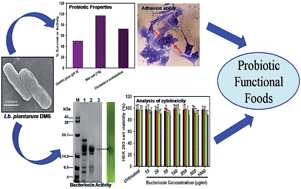Characterization of a noncytotoxic bacteriocin from probiotic Lactobacillus plantarum DM5 with potential as a food preservative
Abstract
The aim of this work was to purify and characterize the bacteriocin produced by probiotic Lactobacillus plantarum DM5 in order to evaluate its potential as nutraceuticals. Lb. plantarum DM5 exhibited in vitro probiotic properties such as high resistance to gastric juice and bile salt, adherence to human adenocarcinoma (HT-29) cells, bile salt hydrolase and cholesterol assimilation activity. Moreover, Lb. plantarum DM5 showed bacteriocin activity against several major food borne pathogens. Zymogram analysis of purified bacteriocin (plantaricin DM5) showed a molecular size of ∼15.2 kDa. Plantaricin DM5 was sensitive to proteolytic enzymes but stable in the pH range of 2.0–10.0, and it was heat resistant (121 °C for 15 min) and remained active upon treatment with surfactants and detergents. Cytotoxicity analysis of plantaricin DM5 on human embryonic kidney 293 (HEK 293) and human cervical cancer (HeLa) cell lines revealed its nontoxic and biocompatible nature. To the best of our knowledge, this is the first study on the isolated strain expressing probiotic properties and broad antimicrobial activity without any cytotoxic effect on mammalian cells from indigenous fermented beverage Marcha from India, and thus contributes to the food industry as a novel bio-preservant.


 Please wait while we load your content...
Please wait while we load your content...